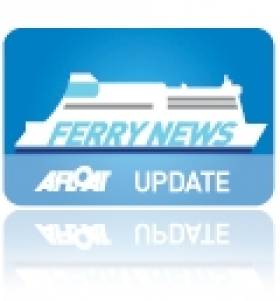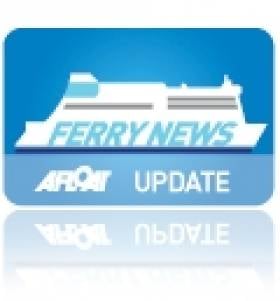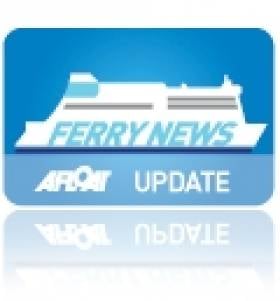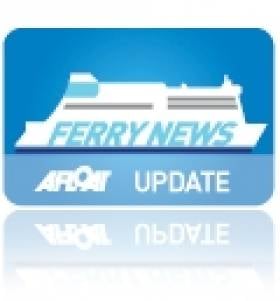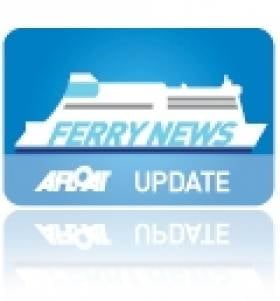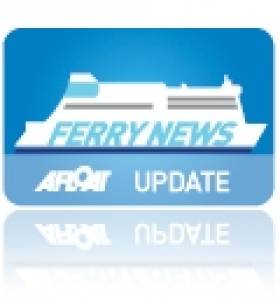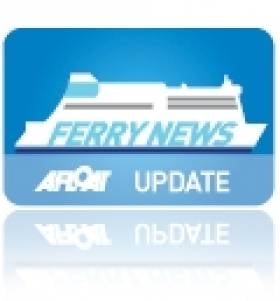Displaying items by tag: Dun LaoghaireHolyhead
HSS Off-Service till Second Year of Seasonal Summer Sailings
#HSS FASTCRAFT – Now that the HSS Stena Explorer has completed her Dun Laoghaire-Holyhead sailings on the day before Little Christmas, it would seem to be part of human nature to only value something when it is lost and only to know how precious it is when it returns, writes Jehan Ashmore.
The HSS had operated albeit briefly "12" days of service over the festive period, in what was somewhat of a surprise move by Stena Line to re-introduce these special sailings, considering that they did not take place during the same season of Winter 2011.
As previously reported on Afloat.ie, in that year, for the first time, the daily operated services on the route closed, breaking a historical link of around 200 years of continuous 'ferry' services. So in the following year, 2012 was marked as the first to operate a seasonal-only service running from Spring to September.
The reduction in sailings could not be so stark since the HSS's introduction in 1996, from the heydays of up to five daily round-trips during peak-season times. A decade later the service began to decline, with reduced frequency and longer passage times.
Despite last weekend's final sailing, the HSS reopens the route for a second year of seasonal-only summer sailings starting 22 March to early September. Once again many will welcome the sight of the HSS looming over the horizon from the Kish Lighthouse and speeding her way across Dublin Bay before entering the harbour mouth.
HSS Fastcraft is Back for Christmas and Beyond
#HSS FASTCRAFT- Stena Line's HSS fastcraft as previously reported on Afloat.ie is to return to the Dun Laoghaire-Holyhead tomorrow, operating the 2hour 15 minute service on 12 selected days during the festive period.
Christmas Sailing Schedule: The fastcraft HSS Stena Explorer will operate sailings on the following dates: 20-23 December, 27-30 December and also early into the New Year between 2-5 January 2013. During these dates the HSS will operate one departure from Dun Laoghaire and Holyhead daily. For HSS sailing schedules and also on the Dublin-Holyhead route, click LINK.
2013 Sailing Schedule: The fastcraft HSS return's to open the 2013 main season on the Dun Laoghaire-Holyhead route starting 22 March. The service will continue through the high-season months and until 10 September.
Stena Line are the only regular commercial company operating out of Dun Laoghaire Harbour and where as previously reported on Afloat.ie the port in 2013, its second season in developing the cruise sector, is to attract 10 cruise callers including Cunard Line's Queen Mary 2 in mid-May.
End of High-Season Stena HSS Sailings
#FERRY NEWS- Stena Line's seasonal-only Dun Laoghaire-Holyhead route run by the HSS Stena Explorer finished its last sailing today with a lunchtime departure bound for Anglesey. However the HSS service will return for twelve days over the Christmas / New Year period, writes Jehan Ashmore.
In the interim period the company will maintain their Dublin-Holyhead year-round route served by conventional ferries, Stena Adventurer and Stena Nordica. For information on the 3-hour 15 minute route and sailings schedules click HERE.
This is the second year in which the reduced HSS service has been operating to a single daily round trip, as Stena Line in recent years has strived to reduce costs on the 120 minute route served by the more expensive to run fuel-thirsty catamaran fast-ferry.
When sailings return on the Dun Laoghaire-Holyhead route during the festive period (see details), they are scheduled to run during three short stints, they are as follows: 20-23 December, 27-30 December and 2-5 January 2013.
Seasonal Start for Three In A Row
#FERRY NEWS – By this weekend three seasonal-only operated routes from the island of Ireland will have resumed service since the recent change of the clocks marking the start of summertime, writes Jehan Ashmore.
Sailings started today on Stena Line's Dun Laoghaire-Holyhead (120 minutes) fast-craft HSS Stena Explorer operated service. The central corridor route closed last September due to cost-saving measures as previously reported. For further details on sailing schedule click HERE.
The reopening of the Welsh route follows yesterday's launch of P&O Ferries fast-craft sailings to Scotland between Larne-Troon (2 hours) served by the 92m Express. She also runs additional sailings on the year-round Larne-Cairnryan route served by a pair of conventional ferry sisters. To read more information on both sailing route schedules click HERE.
The remaining route to re-open is Brittany Ferries Cork-Roscoff (14 hours) service operated by the 2,400 passenger 'flagship' Pont-Aven, which features an indoor swimming pool. Her first sailing for this year is tonight's sailing from the Breton port.
The corresponding Irish sailing departs tomorrow afternoon and the inaugural round trip is due to be completed with an arrival in France on Sunday morning. For sailing times click HERE.
Dun Laoghaire-Holyhead Service to Start Earlier than Planned
#FERRY NEWS- Stena Line have changed the resumption date of Dun Laoghaire-Holyhead HSS fast-craft operated sailings to 30th March, two days earlier than originally planned and as previously reported on Afloat.ie
The seasonal-only service is to operate a daily single round trip with a 10.00 hours sailing from Holyhead and a 13.15 hours sailing from Dun Laoghaire. Sailing times are 120-minutes and they will run throughout the summer months until 11th September.
Stena Line's Head of PR and Communications, Diane Poole, OBE said: "We look forward to welcoming the HSS Stena Explorer back on the Dun Laoghaire to Holyhead route which will provide customers with even more reason to cross the Irish Sea during the summer months.
"The vessel, which offers excellent onboard facilities, will complement the timetable on our Dublin Port to Holyhead route as it offers customers a mid-morning departure from Holyhead and a lunchtime departure from Dun Laoghaire."
For more information visit www.stenaline.ie or call 01 204 7777
Ferry Operator Consider Court Finding
#FERRY NEWS – Senior managers in Stena Line are considering today the implications of a Labour Court recommendation that it increase redundancy terms for 39 workers at its Dún Laoghaire Harbour operation, the Irish Times reports.
The Labour Court rejected the workers' claim for automatic redeployment from the Dún Laoghaire service to Stena's Dublin Port – Holyhead route operation.
Stena's Dublin Port operation is managed by a subcontractor RoRo Services Dublin Ltd, which Stena said had no vacancies.
The ferry company has said the Dún Laoghaire -Holyhead service, which is now seasonal, will reopen in April, as previously reported on Afloat.ie. However, the company told the Labour Court there is currently no work for staff in the south Dublin port.
Workers who are members of SIPTU have been seeking redeployment to Dublin Port or enhanced redundancy payments.
However, while the Labour Court did recommend enhanced redundancy payments, the enhancement is less than that sought by the workers.
In previous redundancies at the company offered three weeks' pay per year of service, inclusive of statutory redundancy. In addition, they had received ex-gratia payments of €18,000 plus an additional €500 per year of service. The Labour Court recommended the €500 per year of service payment should be increased to €1,050 per year of service.
The Labour Court recommended that the company confirm staff in Dún Laoghaire would be given first call on jobs when the Dún Laoghaire service resumes in April.
A Stena spokesperson said senior management at the company were considering the recommendation and would make a statement later in the day.
Farewell as Stena Line’s ‘Lynx’ Fast-Ferry Sets Sail for South Korea
Sunflower 2 is to make bunker calls on the repositioning voyage, firstly in Valletta, Malta before she transits the Suez Canal to the Red Sea port of Jeddah, Saudi Arabia and Columbo, Sri Lanka. From there she transits the Strait of Malacca then through the South China Sea followed by the East China Sea before finally entering the Strait of Korea to her homeport of Busan.
Since 1999 she has served Stena Line's fast-ferry high-season Rosslare-Fishguard route sailings taking 1 hour 50 minutes in tandem with conventional ferry Stena Europe (1981/24,828grt) which currently maintains the year-round 3 hours 30 minutes route. It is believed that Stena Line will not be operating high-season fast-ferry services in 2012.
Prior to her Dun Laoghaire departure, her South Korean crew have been preparing the craft over the last three weeks. Notably there was the removal of all Stena Line corporate livery markings on the hull. Her new name and port of registry were painted at the stern though she retained her original name at the bow which included both symbols of an Irish shamrock aptly to starboard (green) and the Welsh dragon to port (red) to reflect her Irish Sea southern corridor route.
Stena Lynx III departing Dun Laoghaire last year, note her starboard 'Shamrock' at the bow.
In recent years on the St. Georges Channel route she was marketed as the Stena 'Express'. Her final sailing this year was 4 September and three days later she docked Dun Laoghaire at St. Michaels Pier. On the adjacent berth which is designed specifically for and only capable of accommodating the HSS 1500 class fast-ferries.
Stena Lynx III also ran several shoulder season stints on the Dun Laoghaire-Holyhead route with the HSS Stena Explorer (1996/19,638grt) only running during the busier summer months. During this summer all sailings were maintained by HSS Stena Explorer until the route became a seasonal-only service for the first time this year when the last sailing took place in mid-September. The HSS remains in layover for the winter in Holyhead at her dedicated berth. The route is due to re-open in April or May.
The 35 knot Stena Lynx III was launched from fast-ferry catamaran specialists InCAT Pty based in the Tasmanian capital of Hobart. Early in her career the 81m wave-piercing catamaran (WPC) craft served Dover-Calais followed by two seasons between Newhaven-Dieppe when renamed P&O Elite for joint operators P&O Stena Line.
Her predecessors the WPC InCat 74m Stena Sea Lynx, became the first car-carrying catamaran to operate Dun Laoghaire-Holyhead sailings in 1993. The pioneering water-jet propelled craft was replaced in subsequent years by the larger InCAT 78m Stena Lynx II.
She was replaced in 1996 when the revolutionary four gas-turbine engine water-jet propelled HSS Stena Explorer was introduced. A further two sisters of the HSS 1500 class (High-speed Sea Service) were completed by Finnyards in Rauma.
- Dublin Port
- Dublin Bay News
- HSS Stena Explorer
- Dun LaoghaireHolyhead
- Stena Lynx III
- Ports and Shipping
- Dun Laoghaire Harbour
- Stena Line
- Ports and Shipping News
- Ferry news
- DoverCalais
- HSS
- RosslareFishguard
- Stena Express
- InCat
- Finnyards
- Dun Laoghaire Harbour News
- Irish Sea fastferries
- Sunflower 2
- P&O Elite
- Highspeed Sea Service
- St.Michaels Pier Dun Laoghaire
Dun Laoghaire-Holyhead (HSS) High Speed Sailings Close
The core reason to withdraw the HSS on the 120-minute route which is not to re-open until the 2012 season, rests with the high operating costs of the fuel-thirsty fast-ferry which is powered by four gas-turbine engines. In addition the route's generated most of its turnover during the period May-September, leaving the remaining months unsustainable, as such the company wants the route to be seasonal-only in the long-term.

HSS Stena Explorer departs Dun Laoghaire Harbour on her final sailing this season. Photo: Jehan Ashmore
Passengers and freight customers will instead need to use the company's other Dublin Bay route between Dublin Port and Holyhead. The 3 hour 15-minute central corridor route is served by two ro-pax vessels, Stena Adventurer (2004/43,532 grt) and Stena Nordica (2000/24,206 grt) which operate to a year-round schedule, for times click HERE.
What is not certain is the precise date for resumption of Dun Laoghaire-Holyhead services as Stena Line have only indicated that they hope to reopen in April or May nor it is outlined as to what type of fast-craft would operate the route next year.
With today's break in service for at least the next six months, this is the most significant absence of the revolutionary HSS (High Speed Sea Service) 1500 fast-ferry which made her official maiden voyage on the route from Dun Laoghaire on 10th April 1996. The only other notable occasions when the HSS was off-service was for the short spells to allow for annual dry-docking, refit, repairs or when the route in recent years was partially operated by Stena Lynx III.
The 1500 referred to the number of passengers the Stena Explorer could accommodate. She was the first of the three Finish-built HSS 1500 catamaran vehicle capable carrying craft to enter service on three routes from the UK. The next sister completed HSS Stena Discovery entered service in the same year between Harwich-Hook van Holland and the final of the trio HSS Stena Voyager entered the Belfast-Stranraer route in 1997. Several years ago the HSS ceased operating on the Dutch route and the HSS currently serving on the North Channel is due to be replaced by conventional ferries in mid-November as previously reported on Afloat.ie, to read more click HERE.
On the Dun Laoghaire-Holyhead service the HSS enjoyed the boom years, and at its peak there were five daily round trips. From 2006 onwards the routes fortunes began to decline due to the ending of duty-free sales, competition from low-cost airlines, and the increasing cost of fuel.
In order to stave off further losses, a series of cost cutting measures were implemented over the next five years. Firstly the sailing frequency was reduced then the passage times were increased to reduce fuel consumption at the expense of faster crossings. In addition the company resorted to withdrawing the Stena Explorer during the shoulder months surrounding the summer and as previously mentioned these sailings were covered by the Stena Lynx III.
When the Stena Explorer returned for the summer months, the Stena Lynx III switched to her normal high-season spell on Rosslare-Fishguard sailings in tandem with regular route vessel Stena Europe. This year she served as usual on the St. Georges Channel route with the last high-season sailing completed on 4 September.
Stena Lynx III remained initially at Fishguard until making a repositioning voyage to Dun Laoghaire via the Kish Lighthouse last Wednesday. She berthed adjacent to the now disused HSS berth link-span on St. Michaels Wharf. The Tasmanian built craft has spent previous winter layover periods in Dublin and last year in Dun Laoghaire whereas the Stena Explorer is expected to do so in her home port of Holyhead.
At the neighbouring Carlisle Pier, the former terminal where numerous steam-packets, 'mailboats' and the conventional Sealink/British Rail car-ferries served (the last being the Stena Adventurer better known as St. Columba built in 1977) there are plans for a national diaspora museum.
The centrepiece landmark building would form as part of the masterplan proposed by the Dun Laoghaire Harbour Company as part of a concerted effort to offset the reduced role of ferry operations. The masterplan is also to attract cruiseship business amongst other proposals envisaged.
- Dublin Port
- Dun Laoghaire Harbour Company
- Cruise Liners
- HSS Stena Explorer
- Dun LaoghaireHolyhead
- Stena Lynx III
- Stena Line
- Port of Dublin
- Ports and Shipping News
- Ferry news
- Stena Explorer
- HSS
- St.Michaels Wharf
- Dun Laoghaire Harbour News
- Stena Adventurer
- Irish Sea ferry news
- Cruise ships
- Carlisle Pier Dun Laoghaire
- Stena Nordica
- Closure of HSS sailings
- HSS (High Speed Sea Service)
- Dun Laoghaire masterplan
- Diaspora Museum Dun Laoghaire
Stena Line to Reduce Dun Laoghaire-Holyhead Service
Stena Line said the fast craft service would operate until 13th September and would then be suspended until the 2012 season. Two conventional ferries will continue to operate year-round on the company's neighbouring route between Dublin Port and Holyhead.
Stena said it hoped to start the service again in April or May although no decision has been made on an exact date.
Area Director for Stena Line's business on the Irish Sea Michael McGrath said: "Despite all our attempts to reduce operating costs over the last few years, it has not been possible to return the route to profitability.
"We regret that this decision will have an impact amongst our ship's personnel and our port operations staff in Dun Laoghaire but this is a decision that has to be taken for the benefit of the overall business. We simply cannot continue to sustain these levels of financial losses.
"We will now embark on a period of consultation with our staff and their union representatives to discuss the implications of the proposed changes with them."
Stena says it hope to start the service again in April or May, although no decision has been made on an exact date. It is believed around 53 staff will be affected by the decision.
HSS Sailings Resumed
The Stena Explorer had completed her first sailing from Holyhead yesterday morning, the fastcraft having departed the Welsh port at 10.00hrs.
Due to the technical difficulties, the Stena Explorer was not in a position to accommodate passengers on the return crossing, though the fastcraft did depart Dun Laoghaire 'light' (without passengers) at 18.45hrs for Holyhead.
The Stena Explorer resumed service with this morning's 10.00hrs sailing from Holyhead to Dun Laoghaire.
The re-introduction of the Stena Explorer is to provide greater capacity during the summer season compared to the smaller Stena Lynx III, which previously served the route until early January. The HSS will operate the two-hour route with a daily single round trip up to 13 Setember.




























